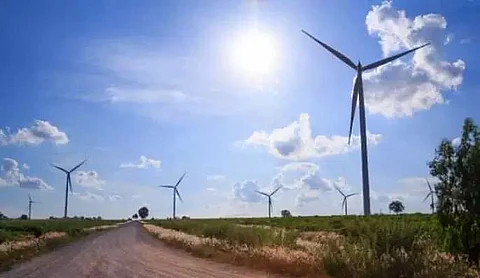
- Home
- Live Blog
- Breaking News
- Top Headlines
- Cities
- NE News
- Sentinel Media
- Sports
- Education
- Jobs

India's goal of generating 500 gigawatts of clean and environmentally sustainable energy from non-fossil fuel sources by 2030 depends on states achieving the desired target. The State Energy and Climate Index (SECI) released by the NITI Aayog has set the benchmark for each state for drawing the roadmap for meeting this goal. The NITI Aayog has described the SECI to be the first index that aims to track the efforts made by states and Union Territories in the climate and energy sector and hopes that an in-depth analysis of individual states will help in enhancing the service delivery on various parameters of energy for achieving India's goals for climate change and clean energy transition. The country has set 2070 as the target year for achieving net-zero carbon emission as part of its climate action commitments. The report states that the energy sector contributes to about 75% of the total greenhouse gas emissions of the country and the paradigm shift in the clean energy transition has the twin objective of ensuring affordable and reliable energy for all and reducing its dependence on fossil-based energy by accelerating the clean energy transition. Almost 80% of the country's energy requirement is met by coal, oil, natural gas and solid biomass and decarbonising the demand and supply sector would be critical to reducing emissions given the mounting pressure on the energy sector on account of the increasing pace of industrialisation and urbanization, the report points out while underscoring the importance of states make use of SECI scores. States have been categorised as the front runner, achievers and aspirants based on their performances. Assam figures among "Achiever states" and the SECI figures will help the state identify the critical gaps and draw parallel with other states to move up along the index to be among "Frontrunner states". The index has been developed based on six parameters- performance of power distribution companies (DISCOM); access, affordability, and reliability; clean energy initiative; energy efficiency; environmental sustainability and new initiatives. Assam has ranked tenth among 20 large states with an overall SECI score of 42.6. Gujarat has topped the chart with an overall score of 50.1 followed by Kerala in the second rank with 49.1 and Punjab figuring the third with 48.6 scores. However, in the parameter of performance of DISCOMs, Assam has performed well with a high score of 67.3 and ranks fourth in the category while Kerala ranks sixth. Performance of DISCOMs assigned 40% weightage in the overall index, Assam can aspire to become a frontrunner state with a sustained focus on improving the performance of the Assam Power Distribution Company Limited. Performance of DISCOMs has been judged based on indicators like debt-to-equity ratio, regulatory assets, transmission and distribution losses and disaggregated scores for various indicators show that Assam still has gaps to address to reduce transmission and distribution losses and sufficient room to reduce technical and commercial losses arising out of non-realization of the billed amount. The state lags far behind other large states in per capita energy consumption, hours of electricity supplied in agricultural and industrial sectors, cross-subsidization, and life-line electricity and tariff due to which it is placed in the bottom segment of rankings for the large states in the parameter access, affordability, and reliability. Likewise, the SECI score state has a huge gap to be bridged in clean energy initiatives which considered three indicators- clean cooking fuel supply, renewable energy penetration and Compressed Natural Gas vehicle penetration. Assam's score in the category is only 4.2 which is ten times less than Haryana which ranks as the best-performing state with a score of 42.9 among large states. Goa with a score of 62.4 being identified as the best performing state among smaller states holds out the mirror to Assam where it stands now and the target it has set to meet the 2030 target. In the parameter of new initiatives which measured indicators like electric vehicle penetration, availability of charging infrastructure for electric vehicles, the proportion of consumers with smart meters, the state has performed ranked third among large states with a score of 17.6, but the Tripura's score of 58.7 which earned the tiny northeastern state the position of the best performing states among smaller states, shows that Assam has a long way to go and cannot be complacent over its ranking. Electrification of railway tracks of the state which has gained momentum in the state and prioritizing implementation of the central government scheme – Faster Adoption and Manufacturing of Hybrid and Electric Vehicles to push electric mobility will determine the pace of decarbonising the state's mobility sector and reducing air and noise pollution. The state harnessing its potential for renewable energy development by undertaking small hydropower projects, solar energy is critical for enhancing clean and environmentally sustainable energy generation. The SECI presents a factsheet before the state government to help it redraw the energy roadmap.